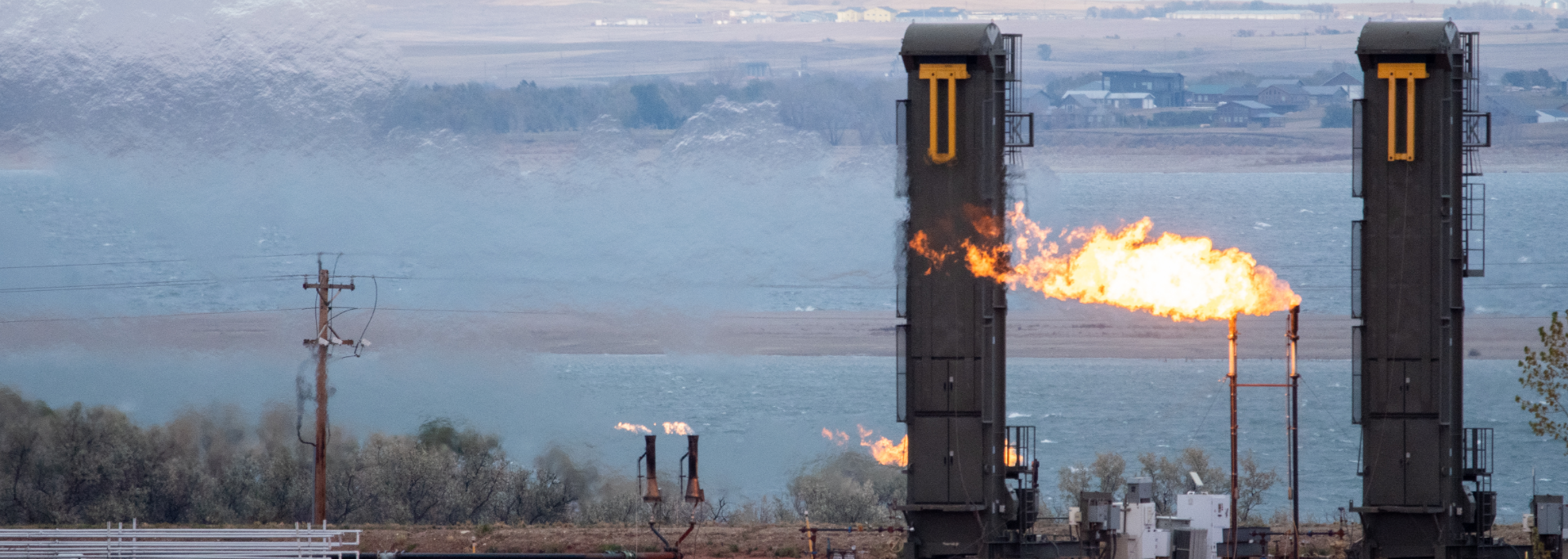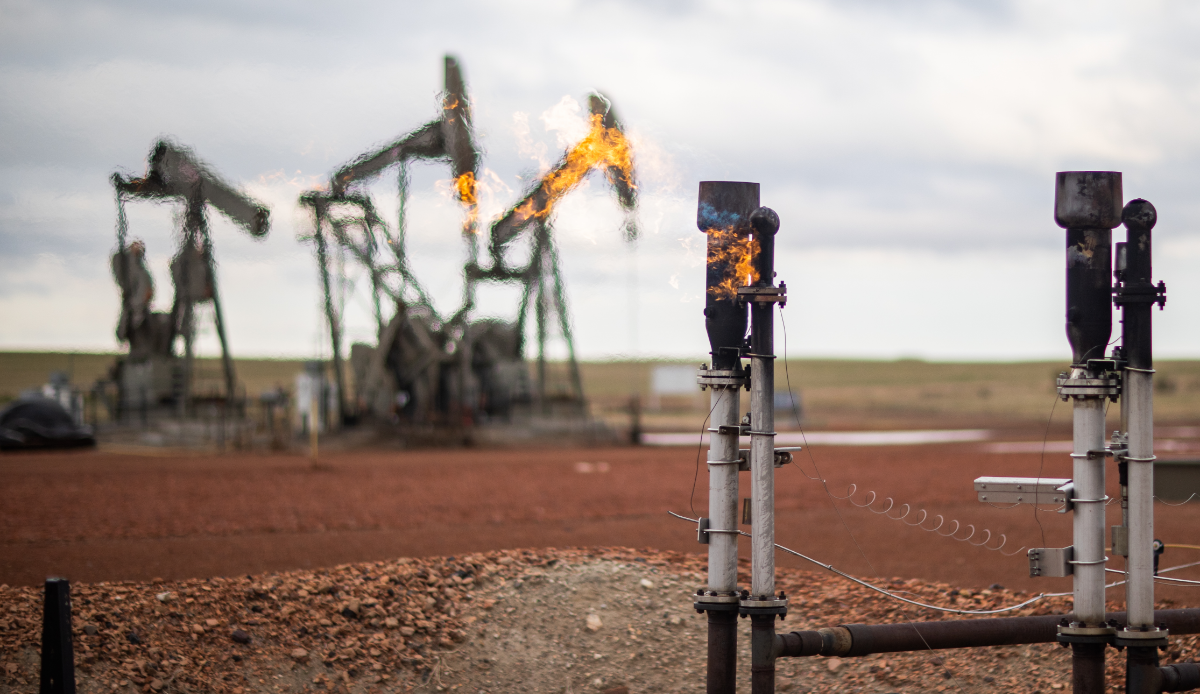
The environmental impact of flaring and venting
Howard Center for Investigative Journalism
Flaring and venting are oil and gas industry practices that allow companies to dispose of the natural gas they extract that is not used on-site or sold. Carbon dioxide and methane, byproducts of flaring, are both greenhouse gases. But methane has more than 80 times the environmental warming potential of carbon dioxide in the first 20 years after its release, which is why experts say cutting methane emissions is one of the quickest ways to slow the rate of global warming. As of 2020, Russia, Iraq, Iran, Algeria and the United States each flared more than any other country, according to the World Bank.
What happens when companies flare?
The oil and gas industry flares for operational, safety or economic reasons, or a combination of the three, according to the U.S. Department of Energy. Operational flaring is often considered an unavoidable step in the oil and gas production process during drilling, maintenance and well testing. Companies also flare during emergency situations. During the process of flaring, or burning natural gas, methane is oxidized into carbon dioxide and water. The more efficiently flares combust the gas, the less methane is released into the atmosphere — though there will always be some methane that escapes. Some flares burn inefficiently and emit more substantial volumes of methane and other pollutants. State regulations set “flare efficiency” standards; the EPA recommends a minimum of 95%. However, frequency and thoroughness of inspections vary across states, making it difficult to know if companies are always meeting those requirements.
 A warning sign for hydrogen sulfide hangs on a fence near a flare in La Salle County, Texas, on Oct. 28, 2021. Natural gas that contains a high percentage of toxic hydrogen sulfide is known as “sour gas.” (Laura Kraegel / Howard Center for Investigative Journalism)
A warning sign for hydrogen sulfide hangs on a fence near a flare in La Salle County, Texas, on Oct. 28, 2021. Natural gas that contains a high percentage of toxic hydrogen sulfide is known as “sour gas.” (Laura Kraegel / Howard Center for Investigative Journalism)
What happens when companies vent?
Venting is the release of natural gas, primarily methane, directly into the atmosphere without combustion. As with flaring, venting can occur at multiple stages in the oil and gas production process for operational and safety reasons. As much as 20% of global methane emissions originate from the oil and gas sector, according to the International Energy Agency. Some U.S. states do not require companies to report the volume of gas they vent and gas they flare separately, obscuring the true environmental impact. Some states prohibit routine venting, but still allow it in certain circumstances, known as exemptions. By directly releasing methane into the air, venting is more damaging to the environment than flaring. The Visible Infrared Imaging Radiometer Suite (VIIRS) instrument onboard some satellites — which can be used to measure flaring — cannot capture the volume of methane vented by the oil and gas industry. Specialized infrared imaging technology is able to measure the invisible emissions from venting, though it is currently mostly limited to aerial flyovers and on-the-ground cameras. New satellite technologies under development will help scientists quantify how much methane is being released by oil and gas operators.
 A pump jack bobs up and down in the fields of North Dakota on Oct. 31, 2021. (Isaac Stone Simonelli / Howard Center for Investigative Journalism)
A pump jack bobs up and down in the fields of North Dakota on Oct. 31, 2021. (Isaac Stone Simonelli / Howard Center for Investigative Journalism)
What emissions do flaring and venting release?
Emissions from flaring and venting can widely vary in content, but scientific studies have identified more than 60 pollutants associated with these processes, including harmful or toxic volatile organic compounds. Flaring can also release several chemicals as a byproduct of combustion, such as nitrogen oxides, carbon dioxide, sulfur dioxide and carbon monoxide. Hydrogen sulfide, an extremely flammable and lethal gas, may also be present in flare emissions. Venting primarily releases methane, but other harmful pollutants may also be present. In addition to the global warming impact of venting, releasing methane and other uncombusted pollutants into the environment contributes to smog as well as health effects that include asthma and heart problems.
How would reducing U.S. flaring and venting combat climate change?
According to the International Energy Agency, the U.S. accounted for about 16% of global methane emissions in 2020. The U.S. oil and gas industry was responsible for around 30% of U.S. methane emissions in 2019, according to the Environmental Protection Agency. Even though carbon dioxide emissions are higher than methane emissions in the U.S., climate scientists agree that reducing methane emissions would slow global warming. This is because methane traps significantly more heat than carbon dioxide during its shorter life span in the atmosphere. Methane emissions from human activities could be cut in half with already available technology, such as leak-detection devices and gas-capture technologies, as well as government- and company-policy changes, according to a study led by scientists with the Environmental Defense Fund.
 A multi-well oil pad burns natural gas on Fort Berthold Indian Reservation on Oct. 25, 2021. (Isaac Stone Simonelli / Howard Center for Investigative Journalism)
A multi-well oil pad burns natural gas on Fort Berthold Indian Reservation on Oct. 25, 2021. (Isaac Stone Simonelli / Howard Center for Investigative Journalism)
How has flaring and venting been addressed at the 2021 U.N. Climate Change Conference?
During the 2021 U.N. Climate Change Conference in Glasgow, Scotland, in early November, President Joe Biden unveiled his U.S. Methane Emissions Reduction Action Plan. This sweeping initiative takes aim at methane emissions from the oil and gas industry, with the EPA, Department of the Interior and Department of Transportation’s Pipeline and Hazardous Materials Safety Administration all being given directives in the move to reduce emissions from the sector. The plan also outlines ways to reduce methane emissions from landfills, the second-largest industrial source of methane in the U.S.
The EPA has proposed new rules, expected to be finalized in 2022, limiting flaring and requiring the sale of or use of the extracted natural gas on well sites. The rules would also enforce record-keeping and reporting requirements to ensure flares reduce methane and other volatile organic compounds by 95%. The Bureau of Land Management and the Bureau of Ocean Energy Management are also working on reducing methane emissions on public lands and waters.
The Global Methane Pledge, formally launched at the U.N. conference, establishes a commitment to reducing methane emissions from energy, agriculture and waste sources. The more than 100 countries that signed on have committed to cut methane emissions by at least 30% globally by 2030. Additionally, the countries have vowed to move toward using better systems for quantifying and tracking methane emissions.
